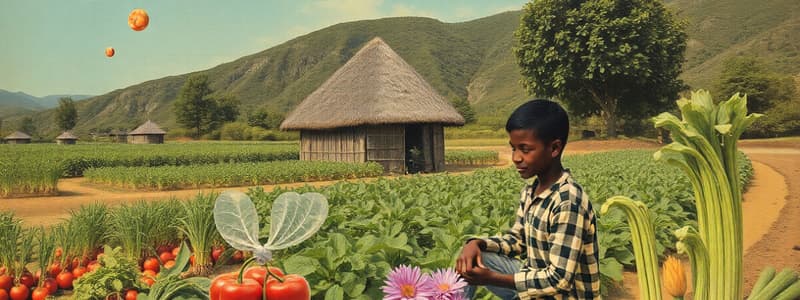Podcast
Questions and Answers
Which factor most significantly limits the presence of pastoralism in tropical forest regions?
Which factor most significantly limits the presence of pastoralism in tropical forest regions?
- Tropical forest environments do not support the types of grasses and vegetation necessary for feeding herds. (correct)
- The lower population density in tropical forest regions cannot sustain pastoralist communities.
- Governmental regulations in tropical regions favor agricultural practices over nomadic pastoralism.
- The prevalence of horticultural societies in tropical regions creates competition for resources that hinder pastoralism.
How does trade activity typically differ between pastoralist and horticultural societies?
How does trade activity typically differ between pastoralist and horticultural societies?
- Pastoralist societies generally have higher trade activity because they rely on trade to obtain agricultural products and other necessities. (correct)
- Horticultural societies focus on local trade, whereas pastoralists engage in long-distance trade networks due to their nomadic lifestyle.
- Both types of societies avoid trade to maintain self-sufficiency and independence from external economies.
- Horticultural societies engage in more trade due to their surplus of agricultural products, while pastoralists primarily trade for animal products.
In what way does the environment exert its influence on food-getting strategies among different societies?
In what way does the environment exert its influence on food-getting strategies among different societies?
- The environment dictates precisely which food-getting strategy a society must adopt for optimal survival.
- The environment establishes definitive boundaries for food-getting strategies, leaving societies with only one viable choice.
- The environment has no substantial effect on food-getting strategies, and cultural choices play a bigger role.
- The environment has a limiting impact on food-getting strategies, making some options less viable, but does not dictate strategy. (correct)
What is a primary reason for the interdependence between pastoral and agricultural groups?
What is a primary reason for the interdependence between pastoral and agricultural groups?
How does individual wealth disparity typically vary between intensive agricultural societies and food-collecting societies?
How does individual wealth disparity typically vary between intensive agricultural societies and food-collecting societies?
Which environmental factor primarily restricts food collection as a dominant subsistence strategy?
Which environmental factor primarily restricts food collection as a dominant subsistence strategy?
How does horticulture typically impact community structure compared to food collection?
How does horticulture typically impact community structure compared to food collection?
What is a defining characteristic of intensive agriculture that differentiates it from horticulture?
What is a defining characteristic of intensive agriculture that differentiates it from horticulture?
Which societal development is most directly correlated with the rise of intensive agriculture?
Which societal development is most directly correlated with the rise of intensive agriculture?
Why do pastoralist societies often trade animal products for plant food?
Why do pastoralist societies often trade animal products for plant food?
How do extensive or shifting cultivation strategies support larger populations compared to food collection?
How do extensive or shifting cultivation strategies support larger populations compared to food collection?
What differentiates horticulture from intensive agriculture in terms of technology and field use?
What differentiates horticulture from intensive agriculture in terms of technology and field use?
Which practice is least likely to be a part of a pastoralist's lifestyle?
Which practice is least likely to be a part of a pastoralist's lifestyle?
Flashcards
Pastoralism
Pastoralism
A subsistence pattern focused on raising and herding domesticated animals.
Pastoralist Lifestyle
Pastoralist Lifestyle
Often nomadic or semi-nomadic communities centered around herding.
Pastoral-Agricultural Interdependence
Pastoral-Agricultural Interdependence
The relationship where pastoralists and agriculturalists exchange goods/services.
Environment's Role in Food Methods
Environment's Role in Food Methods
Signup and view all the flashcards
Horticulture in Tropics
Horticulture in Tropics
Signup and view all the flashcards
Food Collection
Food Collection
Signup and view all the flashcards
Food Production
Food Production
Signup and view all the flashcards
Horticulture
Horticulture
Signup and view all the flashcards
Shifting Cultivation
Shifting Cultivation
Signup and view all the flashcards
Intensive Agriculture
Intensive Agriculture
Signup and view all the flashcards
Horticulture Effects
Horticulture Effects
Signup and view all the flashcards
Intensive Agriculture Effects
Intensive Agriculture Effects
Signup and view all the flashcards
Study Notes
- Economic subsistence refers to how people obtain food, encompassing both food collection and food production.
Food collection
- Food collection involves obtaining food from natural resources.
- This method is predominant for most of human history.
- Currently, it's commonly found in marginal areas like deserts, the Arctic, and dense tropical forests, where agriculture is difficult.
Food production
- Food production started approximately 10,000 years ago.
- It involves cultivating and domesticating plants and animals.
- There are three major types:
- Horticulture, Intensive Agriculture, Pastoralism
Horticulture
- Anthropologists define horticulture as growing crops using relatively simple tools and methods.
- It occurs in the absence of permanently cultivated fields.
- Two types exist:
- Extensive or shifting cultivation
- dependence on long-growing tree crops.
- Horticulturalists also hunt, fish, and some are nomadic.
- General features include:
- more food production, supporting larger communities
- being more sedentary than food collectors
- the beginning of social differentiation and specialization.
Intensive Agriculture
- Involves permanent field cultivation and more complex tools and methods like fertilizers and irrigation.
- General features include:
- societies with intensive agriculture being likely to have towns and cities
- a high degree of craft specialization
- more complex political organization
- large differences in wealth and power.
Pastoralism
- Food production depends directly or indirectly on domesticated animals, focusing on animal protein from milk and blood rather than meat.
- Animal products are traded for plant food and other necessities.
- General features:
- nomadic lifestyle
- small communities
- interdependence between pastoral and agricultural groups.
Food Getting Methods
- Cross-cultural evidence indicates food collection or production aren't significantly influenced by habitat/environment types.
- General patterns:
- ~80% of horticultural societies are in the tropics.
- ~75% of all intensive agricultural societies are not in tropical-forest environments.
- Pastoralism is typically not found in tropical forest regions.
- Environment has a limiting, rather than determining, effect.
Population Density, Settlements, Craft Specialization, Trade and Differences in Individual Wealth Amongst Food Strategies
| Food Collectors | Horticulturalists | Pastoralists | Intensive Agriculturalists | |
|---|---|---|---|---|
| Population Density | Lowest | Low-Moderate | Low | Highest |
| Settlement | Nomadic/Semi-Nomadic | More Sedentary | Nomadic/Semi-Nomadic | Permanent Communities |
| Craft Specialization | None | None/Few | Some | Many |
| Trade | Minimal | Minimal | Very Important | Very Important |
| Differences in Wealth | None | Minimal | Moderate | Considerable |
Studying That Suits You
Use AI to generate personalized quizzes and flashcards to suit your learning preferences.
Related Documents
Description
An overview of economic subsistence, focusing on food collection from natural resources and the beginnings of food production through cultivation and domestication. It covers horticulture, intensive agriculture, and pastoralism. Horticulture involves simple tools and methods, and the presence of shifting cultivation.




